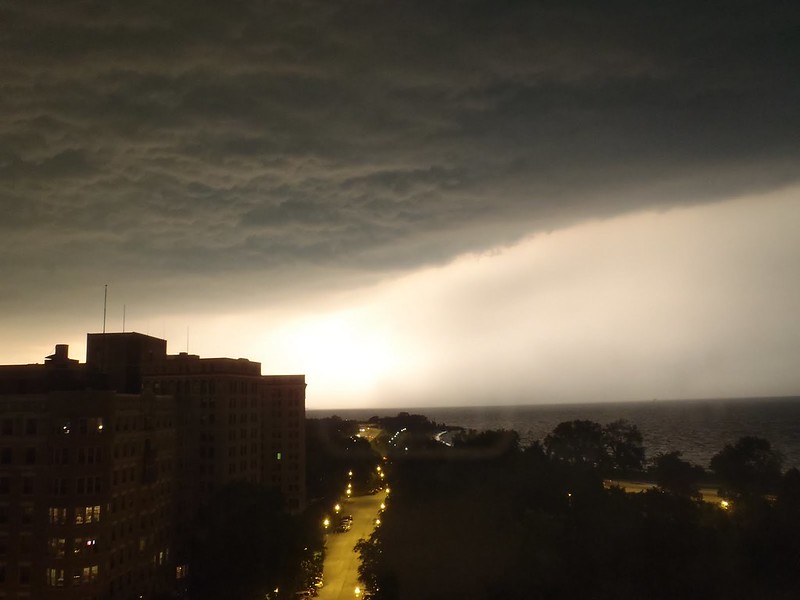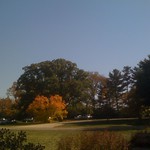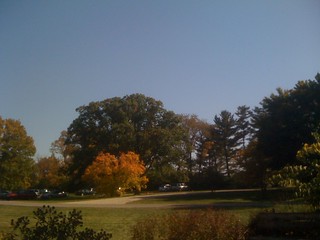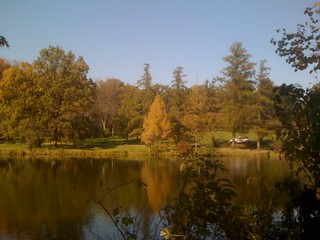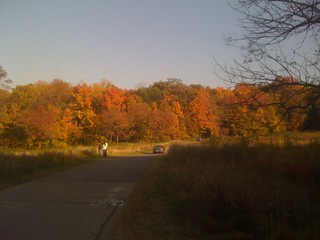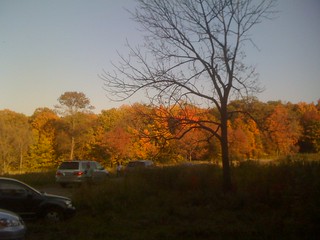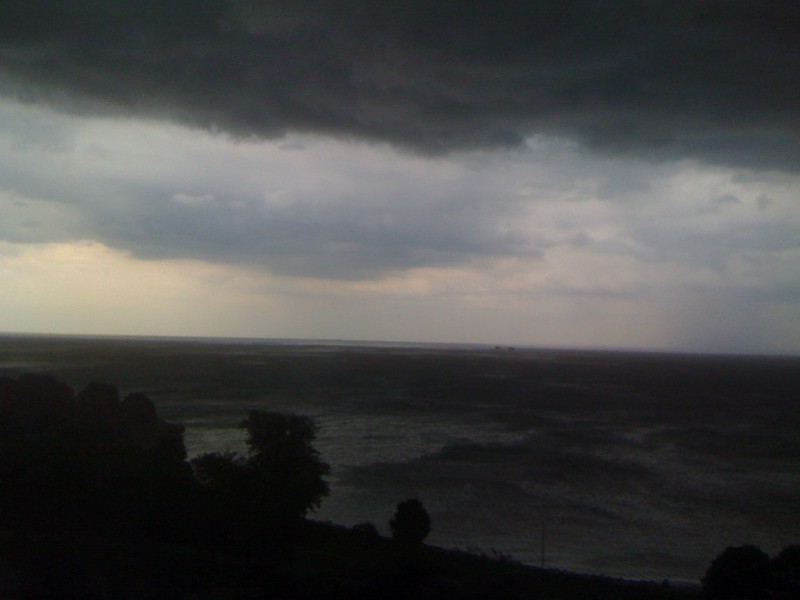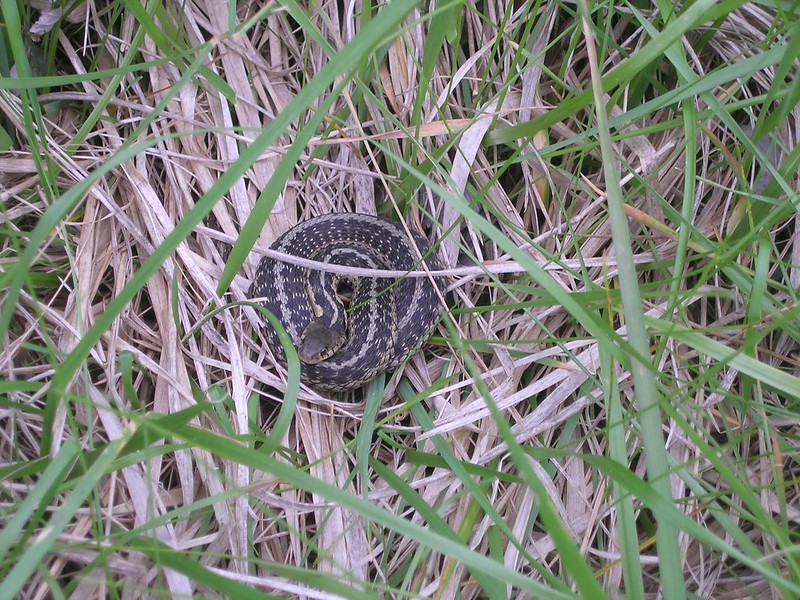
Tag Archives: weather
June 30, 2011: When all hail broke loose
Midwestern thunderstorms frighten me. Perhaps I took The Little House on the Prairie books too much to heart, but one day after I’d been in Chicago a while, I began to imagine that the winds blew harder the lightning streaked brighter, and the thunder boomed louder than at home in western New York. When I thought back to the storms at home, I remembered mostly what we called “sheet lightning” — no visible streak, just masses of clouds flashing with diffused light. Sheet lightning would never strike us, I believed. Living in a trailer, I was more afraid of wind.
Since living by Lake Michigan, I’ve paid more attention to the weather — at first, not by choice, but because some weather systems demanded attention, swooping in from the west to drive out the sunshine. Sometimes it’s just a cloud or two blotting out a little of the light or a freshening breeze; sometimes it’s an entire front visibly advancing, not unlike the onslaught of the crystalline entity in “Silicon Avatar” (Star Trek: The Next Generation). Sometimes it’s a milquetoast of a thunderstorm. It flashes, booms, blows, and rains a bit, then moves over the lake, leaving no ill effects behind except for a few drenched joggers and dog walkers.
Then there’s the storm of June 30. The unpredicted storm of June 30.
When I came home, I thought about changing for the pool. Even as I walked, a few clouds rolled in, and something in the air changed, but I was still considering it because there were no severe weather watches or warnings from the National Weather Service. I looked, but I didn’t see any predictions of what was to come. I was tired, though, and thought I’d wait until an evening when it didn’t look quite so much like rain.
Between 7:30 and 8 p.m., it seemed to be getting darker than it should have been for the time of year and day, even with an overcast sky. That’s when I noticed the cloud front above.
Wow.
By a little after 8 o’clock, the sky had turned a midnight blue. That’s when I heard and felt it.
Hail hitting the windows.
It bounced off so quickly that I couldn’t see how large it was — probably not that big — but the relentless racket made me afraid that the windows would break. The rain, right behind the hail, blew sideways from the east, with some even getting between the window panes. The two trees in front of The Flamingo tossed.
Being alone, I was starting not to like this.
After what seemed like a long time, but was probably at most 10 minutes, the hail stopped, although the rain banged against the glass almost as loudly. Between the hail and rain, and with a little anxiety mixed in, I gave up on watching Star Trek: The Next Generation and headed for the bedroom. The lightning continued for what seemed like hours.
The next morning, I saw many small and a few large tree branches down, including a significant one from the tree across from the bus stop. Overall, the damage didn’t seem that bad at first, although later I saw more large branches that had been torn off trees.
When I came home that evening, I could see from a half block away that the gate at The Flamingo had been covered with caution tape. As I passed by to go to the front, I could see why — one of the two pines along the sidewalk had been uprooted and then had fallen across the cabana roof, denting the edge slightly. It’s the first storm casualty I’ve seen in the garden.
Later, I learned the storm hit only select areas, including, unfortunately, the Garfield Park Conservatory, where the damage is described as “catastrophic.” If you can, please do what I did. Make a donation today to help with the cleanup and repairs and whatever needs to be done to save the plants, especially the ferns.
Thorn Creek Woods Nature Center and Preserve, Will County, Illinois
Ah, spring. It’s almost in the air. When I noticed trees starting to bud, I checked on my favorite horse chestnut, which last year had turned brown in early August as the result of a fungal infection that plagues its kind. It lives, or at least buds.
On Saturday, the 9th, the weather promised to be spring-like, with a high in the 70s. It didn’t start out very promising, though, being chilly and gray for much of the morning. I decided to trust the forecast.
I took the train, but this time didn’t get off at the Homewood station. I stayed on until the end of the line, University Park. Long ago I somehow associated the “University” part with the University of Chicago — I didn’t get out enough, clearly — but on this day realized that the town and station are named for the nearby Governors State University campus.
After passing through a number of urbanized suburbs (the type that don’t look much different from a city neighborhood), I wasn’t expecting University Park, although I should have. It’s at about this point south where one can still find remnants of farms and swatches of open space. The University Park Metra station is hedged only by its parking lots, roads, and fields.
J. met me at the station, and we did a quick driving tour of Governors State. I wondered if there were any coffee shops on campus because there weren’t any anywhere else nearby. Like most suburban campuses, Governors State was designed for driving, not walking or cycling. On our way in, a giant Paul Bunyan dominated the otherwise empty field to our left. At one juncture, a sprawling metal thing perched atop an elevation, less impressive for its form than for its size and positioning.
Our destination was Thorn Creek Woods Nature Center and Preserve, probably the first Will County forest preserve I’ve been to (J. had walked around it one summer evening some time ago). The center is in a Lutheran church build in 1862. Aside from plain white partitions that form a hallway square around the central area where the congregation would have sat, the missing pews, and a brighter color scheme, it’s supposed to be well preserved. It’s authentic enough to lack indoor plumbing; the chatty volunteer pointed me to the portable toilet in the parking lot that everyone, including staff, uses.
The most striking features are the elevated pulpit in the wall and the rounded ceiling. She explained that the stairs were hidden, which I suspect created the effect of the minister appearing mysteriously from nowhere. Even a 19th-century rural minister can have a touch of the conjurer about him.
We bought T-shirts and walking sticks, and J. entered a raffle for gift baskets in addition to making a donation. The volunteer seemed surprised and pleased by his generosity.
As she told us before and after our walk, it was a perfect day for it. While it was 48º F in Hyde Park, it was 67º F and sunny in Matteson. I’d overdressed.
The terrain here is uneven, with the creek cutting through, and trees grow in odd shapes at odd angles to the ground, or so they appear to when denuded of their foliage. Woodpeckers and other birds flitted about elusively. I can imagine how lovely this place must be in the early summer, when the leaves and the air are still fresh, and the biting insects haven’t quite hit their peak.
Partway along, the trail splits a stand of stately pines, looking like a religious-themed greeting card in the mid- to late afternoon sun. I think I’d read that they had been planted by a farmer.
All around the pine stand and what the volunteer called the salamander pond was the sound of what she’d said are chorus frogs. While prominent, the sound wasn’t deafening or even very loud, making me think of dozens rather than of hundreds or thousands. Often I wonder what these areas were like 500, 400, 300, 200 years ago, before farms and Lutheran churches.
Beyond the pines and pond is a larger body, Owl Lake, which also would be even more beautiful on a summer’s day or early evening.
I’d read in 60 Hikes within 60 Miles of Chicago that Thorn Creek doesn’t get a lot of traffic, which doesn’t surprise me as the population density is low, and the preserve doesn’t offer the the unique features and marvels that make destinations of Starved Rock and Matthiessen State Parks in LaSalle County. We encountered a handful of people on the trail, and a young couple parked and walked in as we were getting ready to leave. They’re regulars; the volunteer, also departing, waved to them and mentioned she knew them.
The best character, however was the man, in his thirties, who was heading out as we were heading in. He was walking quickly and joylessly, ear buds planted in his ears with raucous, percussive noise blasting loud enough for me to hear it from 10 or more feet away. There, I thought, goes a man who knows how to appreciate the peace of Thorn Creek — or a busy construction site.
I hadn’t eaten much, so pizza at Chicago Dough Company sounded especially good, as did the pizza-dough appetizers and the pizza-dough cinnamon stick desserts. Who knew that pizza dough could be so versatile!
Changes
Change instills in me apprehension and discomfort, but lack of changes creates a more chilling effect — depression. To me, depression is the anxiety and fear not that life is bad, but that it will always be the same, that there will be no more “bends in the road” to anticipate. Some changes lead to a downward spiral, but many, perhaps most, are more positive. It seems easier to avoid the bad than to cause the good.
It’s a little after three o’clock on a sunny, warm, nay, hot afternoon in October, summer’s final curtain call. Change is all around. The chlorophyll is fading, leaving behind mixed palettes of yellow, orange, red, and brown. The trees in front of the Flamingo green two weeks ago, are casting more leaves than shade. The management has put out the annual call for the removal of air conditioners. Dragonflies no longer rule the day, nor fireflies the night, yet the pesky housefly still pesters the people who dine al fresco.
That was J. and I yesterday at Bonjour, where we ate breakfast before going to Morton Arboretum. We had gone there last Sunday, then on to dinner at Bavarian Lodge in Lisle, but we arrived late in the afternoon and spent a little too much time in the gift shop. A pre-sunset walk around Lake Marmo under overcast skies had yielded a few hints of color here and there.
This day promised to be sunny and warm. My knee (suspected torn meniscus), which had been feeling better on flat land, had taken a turn for the worse Friday, keeping me half awake most of the night. When I woke up early, it was all I could do to get to the bathroom on it, so I went back to taking meloxicam and to wearing a knee stabilizer. I envisioned sitting in the car, being unable to walk down any of the arboretum’s trails, and hindering J. from seeing as much as he could.
Praise be to NSAIDs and stabilizers. As I wandered around the annual Columbus Day book sale, it occurred to me that my knee, unstable and painful for the previous 24 hours, was back to functioning at 60 percent. Walking may not be wise, but how could I not walk among the trees and waters on a sunny, 81-degree October Sunday? As I said, praise be to NSAIDs and ACE. Even after a mile or so of walking, the swelling was noticeably less.
My favorite spot for walking at the arboretum is along the DuPage River, and this was the perfect afternoon for it. Having to walk slowly i in such a place on such a day is no bad thing. Although there had been a line of traffic on both sides to get into the arboretum (one woman, far along in pregnancy, got out of an SUV’s back seat with another person while it was in line, presumably to make a dash for the bathroom), and the parking lots were full to overflowing — understandably, Chicagoans can’t get enough of this last burst of fine weather ahead of five to six months of dreary — we encountered only a few groups of people along the river and a few more at Lake Marmo, where our trail led. More splotches of color were evident, especially around the lake, and in places the tall grasses shimmering under the low sun show display their own kind of beauty.
I would love to have gone further, but one difference between my 20-year-old self and my current self is a new awareness that the body can indeed be broken and that I’d rather prevent that than have surgery or risk the ability to walk normally, without limp or pain. There’s still too much of Starved Rock, Buffalo Rock State Park, and Matthiessen I want to see.
We took the main route through the west side, where we found several colorful vistas — but little available parking. In most cases, we had to be content with taking it all in from the road. Fortunately, those behind us didn’t seem to be a great hurry.
We wanted stop at Joyful’s Café, but Yelp has the hours wrong — it was already closed — so we settled for a brief stop at Bello Tea in Downers Grove. They looked like they could use more business at 5 p.m. on a beautiful Saturday.
J. dropped me off at Argo Tea in the theatre district while he went to work. He didn’t think it would take long. My Plan B had been to catch the bus at State and Lake if it looked to be a long wait. As I was sipping pumpkin chai, a breaking news alert popped up on my iPhone: a southbound #6 bus had run off Lake Shore Drive near the Stevenson Expressway ramp and hit a tree. Hmmm. I sent a text message to J., who called me a half hour later to say, “It looks like I’ll have to work late — would you mind taking the bus?” Hahaha. (I found out later the accident had occurred earlier than the alert, at about 6 p.m., at which time we’d been enjoying the scenery from a logjammed Eisenhower Expressway.)
He picked me up at about 9 o’clock. As we headed past Museum Campus, we could see flashing emergency lights and lanes blocked by flares. Farther south, workers were sweeping lanes, which by then seemed clean of debris. I looked for the bus and signs of the unfortunately tree it had hit, but saw neither. We came upon the bus at the 31st street exit, being towed, its right front side caved in. Later I read that at least 35 passengers were injured.
J. got me home in one piece, then, after tea and cookies, he too made it home whole. There may be more visits to the arboretum, but already I can feel that some of the most beautiful of the changes are behind us, as well as the cast of the shadow of a long, cold winter of unvarying gray. Has it already been five months since I was last intoxicated by the scent of lilacs?
Black water thunderstorm
Work day at Chicago Portage National Historic Site
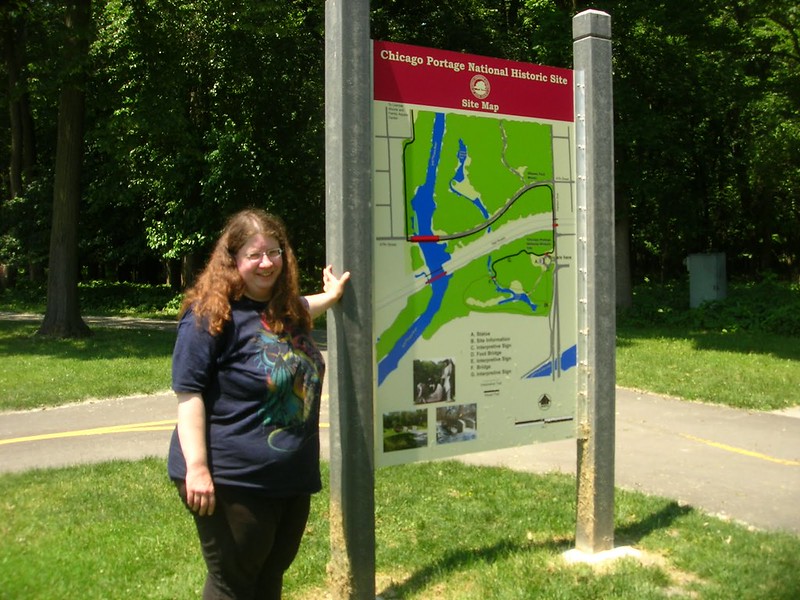
And now for something completely different . . . a more-or-less quick trip west on the Stevenson to Harlem and 49th, where you’ll find the Chicago Portage National Historic Site, one of only two in Illinois (Lincoln’s home is the other). Here La Salle and Père Marquette walked, they say, as of course did generations of Native Americans before them. Just as Europe had its trade routes, so did native North America. A sign along one of the trails notes that designated burr oaks are believed to be more than 200 years old.
We arrived at around 9:30 a.m., a half hour late, looking for work. One lone walker seemed to be there to admire the scenery, so I made an executive decision and took off down the paved trail, where I hoped that we’d run into the crew of Forest Preserve District of Cook County employees and volunteers there for a work day, during which necessary work is done to maintain the preserves. In many cases, this seems to involve removal of invasive exotics — I pictured pulling garlic mustard, which I’d assumed they’d show me how to recognize.
Just as J wondered if we’d gone the correct way, we came upon the group, a couple of the men armed with chain saws. They weren’t here to pull garlic mustard. No, they were cutting down a stand of buckthorn that ran from the trail to the stream and that was keeping the forest floor in perpetual shade in spring, summer, and fall. Others were lopping off branches or using hand saws to cut the larger limbs down to size. Yet more were dragging off the trunks and leafy limbs to brush piles, where they will be burned in the future.
Buckthorn, introduced from Europe, is an invasive species that offers no benefits to our native wildlife and chokes out the native plants that otherwise would add to the diversity our animals and birds need. It’s too dark under a buckthorn stand for wildflowers to grow or, I suppose, for native seedlings to take root. Buckthorn also hosts the soybean aphid; from its name you can guess how much farmers love this little pest. Its sale/purchase/cultivation has been banned in many areas, including Illinois and Minnesota, but it’s too late. It has a pervasive presence in the forest preserves and some parks and is especially widespread in the northern two-thirds of the state.
We introduced ourselves all around, and an FPDCC employee recognized us from an art fair at Swallow Cliff Woods. J remembered that we’d talked about Volo Bog, so he mentioned our visit there and how far away it is. They asked us if we were passing through; we said, “No, we’ve come to work.” They seemed surprised but pleased, and asked us how we’d found out about the work day. When I said I’d seen it on facebook, they seemed even more surprised and delighted. It sounds as though not everyone thinks the facebook presence is effective. Maybe it’s just me, but we’ve gone to a few events, including this one and the art fair, because I’d seen them on facebook. It’s an easy way for me to get timely, information in one place about my different interests. I don’t have to work as hard or think to look for information.
For the next hour and a half I dragged, lopped, and stacked what seemed like a never-ending supply of buckthorn branches and trunks. A busload of high school students arrived to help for credit; at one point someone told them that if they didn’t behave and get to work, they wouldn’t get any. The arrival of so many hands, including young men who wanted to show off by dragging heavy trunks singlehandedly, seemed to spur the men with chain saws. When I looked toward the stream, I could see the sky, and light was dappling the ground below. We had two large piles, possibly three, and fallen trunks and branches littered the ground. And still the men kept cutting. All this was in one small area. I wondered how much buckthorn was left and where.
We learned quickly that buckthorn has that name for a reason. When we weren’t in danger of hitting ourselves or others with limbs or trunks or being rammed by the enthusiastic high schoolers who, like most kids their age, were oblivious to those around them, we were stabbing ourselves on the thorns that grow along the shrub’s trunk. Gloves would have helped with handling the limbs and the loppers, but weren’t necessary. Unlike us, however, the kids had come prepared.
I’d been in pain most of Friday — the result of standing most of Wednesday at National Senior Health and Fitness Day — and hadn’t slept well Thursday. My lower back hurt more than usual. Before we’d gone to the work day, I’d known my endurance would be limited. The heat and humidity of the day, even among the trees, didn’t help, nor did the horde of mosquitoes that decided to go after, of all places, my hinder. I did as much as I could and left at 11 for the car, while J was determined to soldier on until the noon conclusion.
While returning along the trail, I’d noticed that my brother had called and left a voicemail, which he never does. It proved to be four seconds long and soundless. I called him to confirm that was nothing was wrong; when he didn’t answer, I raised an eyebrow. His daughter at home said he was out shopping. I raised the other eyebrow. It turned out to be one of those phantom calls that happen when some part of your anatomy manages to knock against the right button to make a call. While I was talking to him, still on the trail, I exclaimed, “Oh! I have to go!” I’d spotted the iridescent blue black of a bird in one of the bushes off the trail — but I didn’t disconnect quickly enough to switch the iPhone to camera mode and get a photo before it flew off. Not that it would have been a good photo . . .
I was hoping I could claim that I’d seen an indigo bunting.
J’s car, parked in the sun, felt like a damp oven. How anyone can leave a dog in that kind of heat, which builds in only a few moments under the sun, astounds me.
I ran the air conditioner for five or ten minutes, turning it off when he called and told me it would run the battery down. He promised to leave a little earlier, so I tried to find a place nearby where I could use the bathroom and sit comfortably.
Alas, Harlem Avenue is not foot traffic friendly, and I was at the end of my reserves in the heat. I walked only a about a block, to a Shell station, where the attendant said there was no toilet paper. I mentioned facial tissues as a substitute, but she said, a little too quickly and happily, that they don’t sell any. They carry beer for the road, but not a traveling convenience like tissue. Hmmm. I bought each of us flavored water and returned to the car, sitting in the shade of the driver’s side and enjoying the occasional slight breeze that wafted through.
At 12:15 or so, J appeared, saying he’d seen a brilliant blue bird in the treetops after he’d crossed the bridge over the stream — possibly near where I’d seen it. He swears he saw white and is unconvinced of my indigo bunting identification. I’ll never know.
Next, having bought croissants at Bonjour but not eaten them, we headed to Riverside Restaurant for a taste of Bohemia, then to Riverside the town for a walk along Salt Creek, where we encountered mostly robins, butterflies, and a pair of mallards. Outside the forest preserve, Riverside itself seems to be a charming town, with lots of park space and picnic and seating areas near the water.
There are a few more work days scheduled at Chicago Portage this summer. It’s a good way for a soft office slave to break into a healthy sweat, meet people, enjoy the forest, and even see a colorful bird or two. J would like to do it again. Try it. You might like it.
29 May 2010
Kankakee River State Park
22 May 2010
As I took Metra to Homewood and walked to Blueberry Hill Pancake House to meet J, I started to get the idea the day might prove to be steamy. It was overcast and looked like rain, but the forecast was for afternoon sun. And a temperature of 89 degrees F.
When he arrived, we ate half a breakfast of champions, boxed the rest, then went to pick up something he thought he’d forgotten but was actually in his trunk. On the way, we stopped at Heritage Health to pick up something for a little picnic. After fueling at Caribou (something iced for me — already steamed), finally we left for Kankakee River State Park.
Past Frankfort on Illinois Rte. 45, the vista opens up onto farmland that in some inexplicable way is more attractive than much of that further downstate. Perhaps it’s the use of tree lines and fences, or the nature of the houses, although the land itself is just as flat and monotonous. We passed a traditional white frame church set close to the road, a small cemetery beside it. It was like seeing something from another era, perhaps that of Laura Ingalls Wilder, tangible yet not quite real.
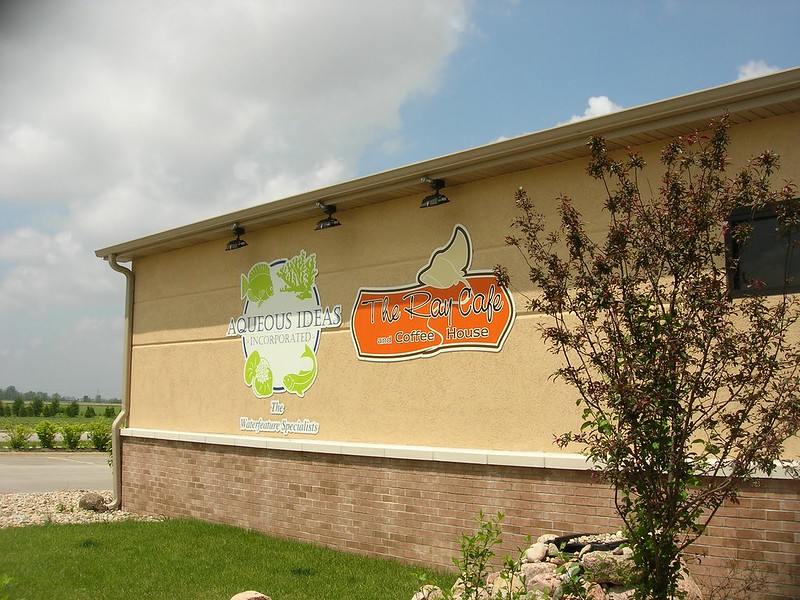
Further on, a sign led us down a side road, where a building that looked new — dirt was still piled up in front — was divided into a café and an aquarium store. The combination would have seemed odd anywhere, and, in an area where the main retail venues seem to be gas stations (something has to power all those John Deeres), I wouldn’t have thought of a burning need for either a café or an aquarium store. Alas, neither was open yet — perhaps they’re still in the throes of getting started. Too bad; the café looked like a potential gem.
Closer to Kankakee, we made another detour, this time to Office Max to replace the car charger I’d bought for the iPhone. At this plaza, two of the biggest stores, including a Petco, had pulled out, leaving behind only the marks of their old signs. The parking lot was mostly empty, with only a handful of cars in front of Office Max. The three male employees seemed happy to talk to anyone. Noting my Midewin National Tallgrass Prairie shirt, one asked me if I’m a conservationist. We talked a little about the Gulf oil disaster, and I left him with something new to research — dead zones. It was a well-stocked, bright store, but the empty storefronts and parking lot reminded me of South Shore Plaza less than 20 years after it had opened to great fanfare. I wonder if this place has been hit especially hard by the recession, if something bigger and better had come along nearby, or if it had been in trouble already for other reasons. And if it will make a comeback, or if it’s turned the corner on the road to nowhere.
I wonder how the café and aquarium store will fare.
Driving around this area is interesting, especially as you cross the river. Just as Wauconda made me think every small town should have a feature like Bangs Lake, this area made me think how fun it would be to live near a river — a clean, wide river with banks that aren’t shored up by concrete, where the current is fast and free.
The Chicago River does not count.
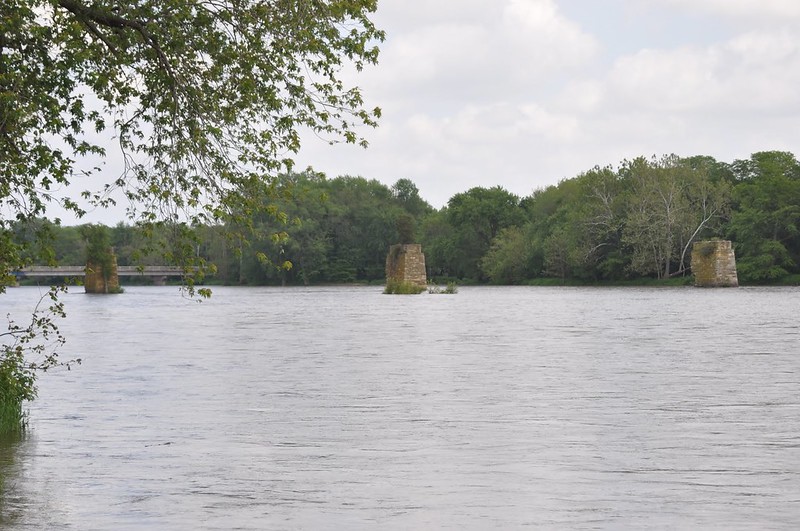
Kankakee River State Park is long, with many designated hunting and fishing spots. As we crossed a bridge over the river, we spotted stone supports for another bridge in the stream — but no span across them them, only some trees of respectable size atop them, rooted in the rock piles. A world without people indeed. We drove into the fishing area on the other side to get some photos. Walking along the water’s edge, we could see why swimming in the Kankakee is not allowed — the current is swift. Even a great swimmer wouldn’t want to be caught in it, plus there are other hazards, like undertows. Its fast flow fascinated me, so unlike that of most of the small rivers around here, the Chicago, the Des Plaines, the DuPage. I thought I may have overheard someone say that the Kankakee was at or close to flood stage, but I was doubtful. Still, it flowed, carrying a log rapidly, relentlessly in its current. Will that log ever touch land again, or will it spill out into the Gulf, along with millions of gallons of oil?
We drove to the visitor center, where live animals (turtles, fish, snakes) and stuffed (mostly birds) help to educate people. One beautiful heron, a sign explains, met its fate when it became entangled in fishing line. What a horrible way to go. Leave only footprints, take only memories (or photos).
We crossed to the other side, where a bridal party was having photos taken. We walked out onto an observation deck, then over a wooden bridge and partway down a trail. In our wanderings we found Smith Cemetery, full of eroded limestone markers from the mid-1800s, many of them for children. One marked the grave of 10-month-old twins, Gay and Jay, who died 10 days apart. The heartbreak . . . someone had filled around the flat stones in the ground with cement, I suppose to protect them, although they are still at the mercy of the elements. I couldn’t help but cringe when a little girl walked on the stones with their worn and increasingly illegible writing. Soon Gay and Jay will be unnoticed by visitors, although the stone marked only with LOVEABLE remains sharp for now.
As we came close to the picnic area, J. suggested we eat before seeking the trail to the waterfall. By now, it was about 4 o’clock, so this seemed like a good idea. I retrieved the bag from the back of the car only to discover that it was coated with oil. Not long before when I had checked, everything had been find, but while we were walking and the car had been parked in full sun, the plastic container with the salad, humus, and pita had warped open, spilling olive oil into the bag. Nothing was beyond salvaging, but what a mess — not quite the relaxed picnic I had imagined.
We realized Rock Creek was across the street, so we parked and found the self-guided trail — except I didn’t realize the significance of the numbers until we had already passed most of the markers; then it occurred to me they corresponded to the comments in the printed guide. I plead tiredness.
This isn’t a particularly difficult trail, although near the beginning the incline was muddy and slick. It passes through trees, then becomes more open where it parallels the creek. At one point, the guide notes, it was a former landing strip, so here it’s paved.
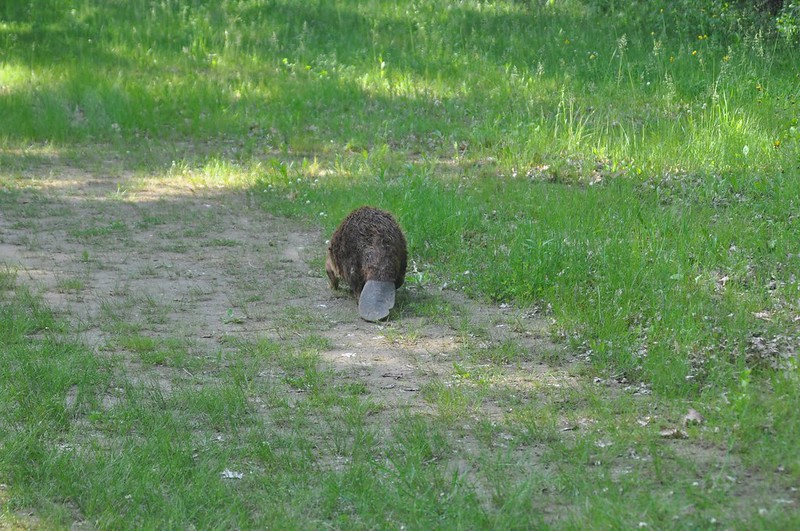
Not too long after we had come into a more open area, I exclaimed in a whisper without thinking, “BEAVER!” A beaver was waddling in front of us, a little off trail. At the same time a group of perhaps 8 to 12 people was headed toward us, trapping the beaver between our groups. The other group respectfully gave him a wide berth, but he didn’t seem to appreciate their sheer numbers. He stopped, turned toward them, and indicated his displeasure through body language and perhaps sound. They sidled around the side of the trail closer to the creek while we hung back, although he seemed less impressed by the two of us. As the other group passed, I said to a man, “They said to look for animal tracks, but not the real thing!” He said they too had never expected to see such a sight.
He was missing a chunk from the right side of his tail, and for some reason — perhaps I am anthropomorphizing — I had an impression of age and perhaps stress and disorientation. Although I have no idea of how he would have returned to the water, which from what we could see runs between cliffs, presumably he’s more familiar with the area geography. It’s sad to think that the beaver was hunted and trapped to near extinction; this one seemed vulnerable behind its bravado.
Soon after, J spotted a baby snake little bigger than a pencil. Unlike the beaver, it quickly disappeared into the grass.
We could see the creek through the trees and could hear what I thought were the falls. Further on, we saw that the rushing sound came from mini-rapids. There’s no swimming in Rock Creek, either; while it’s no Niagara River, it isn’t the shallow, peaceful creek I’d envisioned, either.
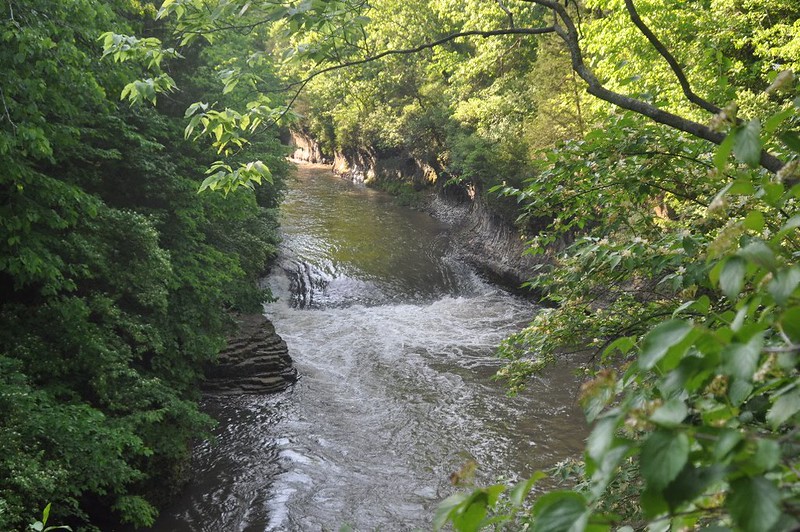
We came upon a couple of paths that branched off toward the creek. J took the first cautiously. They led downward to rocky platforms overlooking the creek. He said the first came to the edge of a cliff, which made me decide not to press my luck, especially as the falls weren’t visible from there. I steeled myself for the other one or two, and ultimately was rewarded with a great view of the waterfall. Don’t expect even the modest height of Starved Rock’s canyon waterfalls; this is a modest creek drop-off. It’s lovely and worth the little climb down, especially if your ability to balance when nervous and tired is better than mine. After taking photos, we relaxed a bit on a bench above and dug out our little bottles of Off! as the mosquitoes made their presence and hunger felt.
On the trail back, we were passed by a boy and two girls, teenagers, on horses; they were from a nearby camp. I’d like to see the world from horseback.
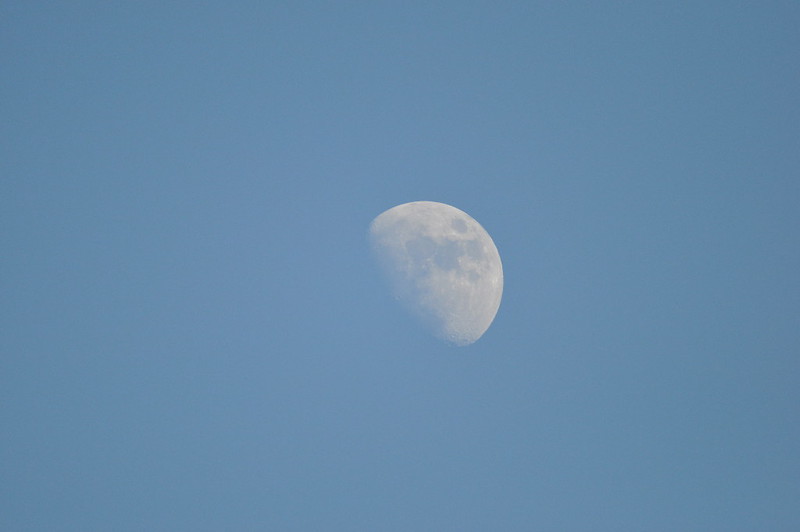
In the parking lot, J set up his monopod and took photos of the waxing moon. Used to my own blurry attempts, I was surprised to see that he’d managed to capture some of its features.
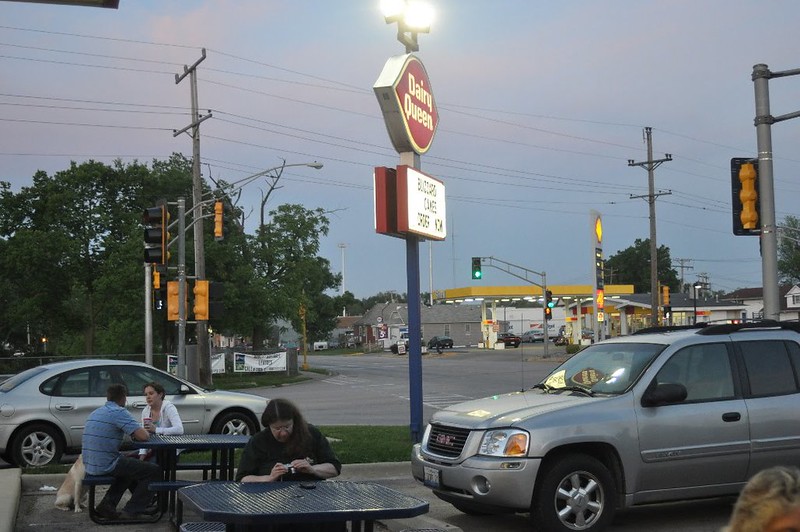
Our next stop was Blue’s Café, a diner that’s probably less throwback and more relic. We managed to get in our meal before the 8 o’clock closing time and to get pie to go. Then we detoured to Dairy Queen, where it was warm enough to sit at the picnic tables outdoors. I can almost picture the Dairy Queen on the road I used to take to Armor, in New York, 35 years ago.
Ice cream at sunset in a river town.
How much better can it get than that?
Voyage to Volo Bog
Perhaps appropriately on a day set aside to see the only quaking bog in Illinois with an open center, the day dawned gloomy. It wasn’t wet or especially chilly, just overcast and gray.
After a late breakfast at Bonjour and some plant and compost shopping at the neighborhood’s annual garden fair, we set out. I didn’t have much hope that we’d arrive before the visitor center, housed in an old barn, closed at 3 p.m., and any hope I may have had faded quickly as we came up on the congealed traffic on the Kennedy Expressway (an oxymoron). There’s a traffic sprite that senses when you especially need traffic to flow smoothly and consequently snarls traffic and your plans. After more than an hour of crawling, traffic eased, yet at no point could I see any reason for the holdup other than the usual construction signs, barriers, and equipment. No workers present, at least that I could see. The point at which traffic speeded up appeared to be no different than any of the billions of other points along the way. That accursed sprite.
Finally, but too late, we were north of Lake-Cook Road in less crowded country. Further north, we came upon four enormous greenhouses, fronted by sculptured shrubs, a place called Atrium Garden Center. As we continued, we saw numerous garden centers, nurseries, and landscapers, including one “wholesale to the public.” People in McHenry and environs must take gardening very seriously.
The country closer to Volo Bog retains some of its rural charm, and not far away a sign at the end of a driveway leading to an older farmhouse advertises “farm fresh eggs.” A temptation if I had had room in my refrigerator. Sigh.
At last we arrived, nearly two hours after setting out. The visitor center was closed, but I picked up information outside the entrance, and so we set off on the Volo Bog Interpretive Trail.
This trail, which I had covered in the mid-90s with a group of volunteers from Lincoln Park Zoo, begins on a boardwalk over the surface of the bog. I remembered what to expect, but behind me I heard J say, “Whoa!” as the walk listed a bit to one side. Ahead of us a couple in late middle age were taking it very slowly. J and I discussed how deep the water might be. We suspect that you’d just get wet if you fell in, although it would be hard to haul yourself out if the bottom sucks as hard as saturated forest mud can (I’ve had athletic shoes sucked off). J marveled at the hinged construction, while I thought the boardwalk is looking worse for wear than I remembered. At one point further into the vegetation I think it morphed into recycled plastic. Across the open water we spotted large white wading birds, and along the walk we found curly-leafed plants, some mushrooms, and a type of flower with one white petal shading prominent sex organs. These aren’t the kind of plants you’re going to find in any garden center.
At the end, a yellow warbler called, his red-streaked breast visible through binoculars. ON the ground below, a Canada goose family blocked the path, while a second family obstructed the way to a viewing platform. We didn’t go to the platform, but as we drew closer one parent, then each of six goslings, then the other parent methodically and unhurriedly dropped into the water as though their movements had nothing to do with our approach; they had been planning a swim anyway, their attitude conveyed. It was a brief foray; they circled the little pond and came back out on the other side of the deck. See how casual that was?
We crossed over to the longer Tamarack Trail, which is supposed to be a 2.75-mile loop. The entire area is hopping with bird life; I spotted a flicker a few minutes into the trail, and then a bird I still haven’t been able to identify (I’m not a good birder). We spent a lot of time listening to and photographing it. In this area and a little further down, we got a good look at the white wading birds, one or two of which obliged us by flying. Black legs, yellow bills — I’d guess snowy egrets.
Past here, the trail veered a little away from the water, and we started to feel like we’d walked a fair distance. It was about then that we came upon a half-mile marker. .5 mile; that’s all we had walked. So far, this had been an easy walk, but I’d felt every inch of it.
In these tamarack woods bursting with birds and other life, we heard a lot of odd sounds, clicking, whirring, chirping, creaking, and the like. I thought I heard an odd sound now. Then, to the right, we saw a pair of sandhill cranes slowly and gracefully fade from view into the vegetation before J could dig out his camera. Here, birds don’t seem to flee in a panic — they just move slowly away, not wasting energy.
The trail continued through open and wooded areas, usually somewhat close to the water. By the time we came to a plastic boardwalk across the bog, which I thought must signal the beginning of the end (but didn’t), I was dragging.
This boardwalk was a bit of a challenge. For one thing, as the signs warned and as I immediately experienced, it’s slippery. I cut back on my speed, not wanting to do a split across it. This walk is also warped, whether from heat or other causes, so it twists a little like something in an Escher painting, with one side higher than the other in several places. It wasn’t a long walk across, but a tiring one between the small steps and the constant adjustments in balance (whether truly needed or not).
At some point we saw a 1.0 mi. marker. Unreal! At Starved Rock, we would have earned a view of the river or a canyon by now.
So far we’d met only one group, an extended family that had backtracked and ran into us not far from the trail head. Now we heard a huffing and puffing behind us, and a middle-aged endomorphic jogger passed us. He wasn’t in either bad or great shape, but we were surprised when he passed us again what seemed to be a short time later. We speculated about where he must have parked his motorcycle.
I wasn’t feeling any perkier, and we weren’t even at the 2.0 mi. mark.
A sign by a side trail promised a viewing platform, I couldn’t see it from partway along, and J, who went further but not far enough, didn’t find it, either. At one or two vantage points, a crude bench offered a good place to rest and take in the scenery. Ahhh.
Close to the en, perhaps even past the 2.5 mi. mark, a series of benches in a V shape seemed to form a mysterious theater under the dense canopy of the trees. I’d like to find out if they’re used for presentations or the like. Perhaps they’re part of a forgotten druid ritual. We sat briefly in the dappled shade looking out at the trees and grasses glowing in the low rays of the western sun.
Regretfully passing the farm-fresh eggs, we sought out Wauconda and Lakeside Inn. Downtown Wauconda is centered on Bangs Lake, which looked lovely against the setting sun, even captured by my iPhone camera. Small towns everywhere might benefit from having a similar feature that draws people and encourages a sense of community and well being.
Dinner consisted of fattening comfort food and fascinating conversation at the next table. Three women and two men carried on a lengthy discussion about the weather, the rain, and the horrors of flooding. From the little I know of this area, this didn’t surprise me.
Meanwhile, the live entertainment had arrived, two musicians, one of them blind. The servers and his performing partner steered him through several doorways as they brought in their gear. They started to sing shortly before we finished our meal.
By now, the people at the next table had exhausted the weather as a topic. Someone said, “Is that the black guy?”
“No, he’s a blind guy.”
“I thought the black guy was playing tonight.”
“No, this guy’s a blind guy.”
“He’s not the black guy?”
“He’s a blind guy.”
(Doubtfully): “He’s not a black guy who’s blind?”
And so on, like a Danny Kaye routine minus the snap and humor. I wondered if black musicians are so rare in these parts that “the black guy” is enough to identify a specific individual.
Toto, we’re not in Chicago anymore.
15 May 2010
Spring at Starved Rock State Park

May 8 and 9, 2010
The canyons and waterfalls of Starved Rock have been calling to J., while coincidentally an opportunity for a one-night stay at Starved Rock Lodge presented itself. So off we went after meeting in Homewood and spending most of the day running errands and shopping. The economy must be picking up because traffic was backed up through a half dozen lights, and the malls and stores were packed. Dick’s Sporting Goods, where I wanted to pick up trekking poles, was a little quieter — perhaps it’s not a hot spot for Mother’s Day gifts.
At last we left the southwest suburbs behind in the late afternoon. On the way to the Lodge, J had a hankering to stop at Mix’s Trading Post, a weathered wooden building with a false front situated between Utica’s downtown and the bridge over the Illinois River. From outside, it doesn’t look like more than a small shop, but, like the Tardis, inside it’s enormous. Overstuffed, but big. One room is full of a brand of moccasins and other footwear; Mix’s carries another brand of boots and shoes as well. I was sorely tempted. Biker gear and clothes filled a back room, and in between was a room with a display of carved marble creatures. Here, a ray called to me, but I ignored it. J. bought gifts and a some tinted vintage postcards of Starved Rock and a couple of churches in Ottawa and Streator. I suspect we’ll find our way to Mix’s again.
We arrived at the Lodge in time to go out for a little exploring before dinner. After checking in, we set off to see what we could see. In a field close to the road, we encountered a flock of four turkeys. J. parked in a convenient driveway across the way and got out to dig around in his camera bag in the trunk. Like their predecessors a few months ago, the turkeys weren’t have any of it. Slowly, discreetly, they began to make their way back to the tree line. Just as he was ready to snap a shot, the last one took cover. Later, we found he’d managed to get one shot with his digital camera. At least now he can say he’s seen wild turkeys.
In a quest to find Council Overhang, we parked and walked down a waterlogged trail, at the end of which we found . . . a parking lot. It turns out that the trail head for Council Overhang is at the other end of the first parking lot. We’d gone the wrong way. Taking a trail into the woods toward Illinois Canyon, we found a sign warning us that many deaths had occurred in this area and listed forbidden activities, such as rappelling. Here at the trail head the terrain seemed safe enough. . . .
Not far into the trees we came upon a sheer bluff that must attract climbers. Like the rest of Starved Rock’s features, it’s not high compared to something you’d find out west. But it’s close and enough of a challenge to draw local climbers — and steep and high enough to be dangerous. In the dim, strange light of a cold, gray late afternoon in the thick of the woods, it loomed over us, remind me of how these cliffs and canyons, relatively shallow though they be, seem to contain their own weird, magical little worlds that seem slightly out of time and sync with the world up there or beyond the woods.
Reluctantly, we left to dress for dinner, this time walking along the road to the first parking lot, with J waving to any drivers who passed to thank them for not hitting and killing us on the narrow shoulder. The world outside the cliffs and canyons has its dangers, too.
After dinner at a table by the fire, we found out the pool is open until 11 p.m. on Saturdays. I didn’t have a bathing suit, plus I did have an unexpected, unwelcome visitor, so he swam laps and then soaked in the whirlpool while I observed an obese middle-aged man with his chubby pre-teen son following him, looking just like a shorter, younger version of his dad. I could picture the boy in 35 or 40 years, and the picture wasn’t attractive.
Following the grim, chill Saturday, Sunday dawned sunny and crisp. After breakfast at the same table — no fire because the staff was setting up the Mother’s Day buffet — we walked around the bar’s deck and found a long staircase into the ravine. We went perhaps halfway down and returned; there is no shortage of steps in Starved Rock. As I took them down slowly and cautiously, two young girls with a family behind us bounded past us effortlessly. Count that among the things that make me feel my age and more.
It was time to head out. This time we drove toward Owl Canyon, which was an easy walk from the parking lot, and, ironically, perhaps missed Hidden Canyon in the same area — I didn’t see its sign. We went down a series of steps, at one point drawn by glimpses of water through the trees. At the bottom of this trail, an old bench with a narrow seat overlooks the Illinois River and a rust bucket of an overturned boat. Swallows flitted over the water, then took their ease for few moments at a time in some overhanging snags.
By now it was clear that this was going to be the perfect day to spend in Starved Rock. Spring sunshine, clear skies, comfortable temperature in the low to mid 60s — it couldn’t be any finer for hiking.
We continued along the river, eventually running into a family peering down at something they found fascinating, so we looked, too — and witnessed a pair of snakes in the act of mating. As more people came along, and naturally as J fiddled with his camera to capture them, the pair retreated a little further into the wood, weeds, and rocks by the water until they had mostly disappeared. We left them for good — we thought.
This trail proved to be long and, although not especially difficult, more of a challenge than my mind was prepared for. In a couple of places, narrow bridges without handrails crossed chasms, which disturbed me only after I was over them. They disturbed J not at all, as he set his trekking pole and tripod down and stepped back and forth to take photos. I pictured him taking one step too many and tumbling into the depths, which aren’t that deep but are deep enough. Further along, bridges over shallower areas come equipped with handrails. Someone had a sense of humor.
The trail began to run along a cliff, which bothered me only in the spots where I had to get around rocks or roots, or where it tilted down toward the canyon. If I can work my way around quickly, I’m all right, but if I have even a moment to think, I doubt and panic. Strangely, I went past one area easily enough getting into the canyon, but on the way out had to scoot over it with my butt out of fear, even as I told those behind me to go around if they could.
Once down in the canyon, I stopped short of going into the waterfall’s basin because the downward slant of the rocks perturbed the unthinking part of my brain — or perhaps the part that remembers a fall on a slope or some misstep? Everyone else clambered easily down, and J tried to cajole me, which only upset me, enough to make me cry. If once I’ve hesitated, then I need to talk myself into making the next move in my own time. I was also starting to worry about whether I could make it back, and if I could manage my biological urges ‘til then. I never felt so restrained and anxious when I was young — or did I?
The canyon is gorgeous, worth the sweat, anxiety, and tears. I’ve always wanted to stand behind a waterfall. While this was hardly the torrent of Last of the Mohicans (the waterfall was the only part of the movie I liked), it felt like magic to stand under the overhang and the drips that seep through and to see the water from that unusual, sheltered perspective. Judging from the traffic in the basin, I’m not the only one with that particular fantasy. Meanwhile, kids from 7 to 17 were climbing fearlessly on the narrow tilted ledges in a way I envied. But I was never like that, even as a kid.
Before we’d left for the lodge, J’s digital camera had started to give him a “lens error” — possibly he’d bumped it on the zebra finch cage in the lobby. Now when I tried to take a photo of him at the waterfall, his film camera died abruptly, mid-snap. He’d been remarking about the play of light along the top edge of the water as it fell, and now we wondered if that roll of film were going to be salvageable. After all that walking and putting up with my angst, the photography hobbyist was down to a partly functional digital camera and my iPhone camera.
Unduly worried about the trek back (which included going up all those steps at the end), I nagged him to leave. Partway down the trail, and after my panic, to his horror he noticed that he’d left his camera backpack behind. Yikes. I found a spot to sit and wait while he retrieved it — I hoped.
While I waited, people came and went. After a few minutes, a large dog that didn’t seem to have sensed me came around a bend and spotted me. Startled, he lunged at me and almost pulled the young woman at the other end of the leash over. Even as they passed, he kept leaping toward me. Methinks that puppy could use a lesson in trail manners and safety.
After about 15 or so minutes J returned with his backpack. Back at the river’s edge, we encountered another family fixated the/a pair of mating snakes; I couldn’t remember if they were in the same spot as before, but they were now on top of a wood pile rather than under it. An older boy with the family said that he was going to “get them” when they were done, so I stayed until they left, which gave J the opportunity to take photos with his disabled digital. After we reached the woods, we ran into him again, this time alone, and I mentioned my concerns to J. He thought it was just a pose, something an older teenager says to appear important or tough. Because some boys act on their posturing, I was still afraid for the snakes. I can only hope that if he did try to “get them,” they managed to slither off into the pile or the water. J also pointed out that they were in a place that would be difficult for anyone to reach. I hope he’s right.
That’s me — maternal and protective toward fornicating reptiles.
Our next objective was to try to find a battery for J’s film camera in the hope that that would revive it. First, we tried the Starved Rock Visitor Center. No batteries, but he did buy a book on 60 places to hike within 60 miles of Chicago. That should give us ideas for a while. On the way back to the car, a man told us that we’d just missed a boat ride but could catch the next. “Free today for mothers,” he said helpfully to me. “Well,” I said doubtfully, “I have a cat.” “Ah.” Even if we had had time, I’m guessing I didn’t qualify for the free ride. As for batteries, we had no better luck in Utica, where the grocery store was closed — possibly earlier than usual because of Mother’s Day.
It was about the time I’d wanted to leave for home, but we headed toward Ottawa and Kaskaskia Canyons in the hope we could see something interesting, like more waterfalls. A man returning up the trail told us that the canyons were probably a quarter of a mile or so away and were “well worth the walk.” This sounded promising, as did his reassurance that it was a relatively easy walk. “At Kaskaskia Canyon, if you take the lower trail your feet will get a little wet.” This sounded endurable.
For the most part, he was right. The trail to Ottawa Canyon is uphill, but neither steep nor precarious, and it seemed like a pretty easy walk compared to our previous endeavor.
Unfortunately, getting to Kaskaskia Canyon required a little more effort at the same time I was growing increasingly tired and cranky. I don’t think we found the upper trail the man had mentioned, and we did get our feet wet crossing the stream several times as solid ground ran out or barriers arose. As we scouted for the narrowest or most shallow places to cross, I was ready to give up. Where went my spirit of fun and adventure?
As the man said, Kaskaskia Canyon is worth the wet feet. In the late afternoon light, with fallen trees leaning against the waterfall, it looked especially remote and wild. A few people lingered, including a no-nonsense photographer with a tripod for whom descents, rocks, roots, water, and other obstacles presented no barriers. Something else for me to envy — that confidence and ease with one’s own body and its abilities.
At last we really had to leave. On the shoulder of the road I spotted large birds that, when we stopped, awkwardly took off and flew to the lowest branches of the nearest tree. I had thought “turkeys” — I must have had turkey on the brain — but then we noticed a carcass on the shoulder. We’d interrupted turkey vultures at table. By the time J had dug out his partially disabled digital camera, they had evaporated into the dimness of the tree’s shadows. Of course.
The Nodding Onion was closed, so off we went to Chicago and dinner at Bar Louie — from rural pine lodge to urban chain sports bar in only a couple of hours.
The lusty month of May at Midewin National Tallgrass Prairie
During one of our return trips from Starved Rock State Park, I’d noticed something new to me — Midewin National Tallgrass Prairie. We couldn’t find a convenient entrance, so we made a mental note to check it out on another day. This was the day.
For me, May 1 began with breakfast at Bonjour, while J had the less pleasant task of going to a dentist’s appointment. We met at the Homewood train station, made the obligatory trip to Caribou, and stopped at Walgreens (I had a premonition that wet wipes would come in handy). At last we set off down I-80.
I wasn’t sure the welcome center would be open as I didn’t know how they define “summer,” but it was, and was worth the stop. Graphics showed the history of the area, how the prairie was formed, and how it shrank to less than .1 percent of its former extent. The graphics alluded to the Black Hawk War, for which, we had learned the previous week, Abraham Lincoln had signed up, and the forced removal of the Potawatomi from Illinois. J picked up some goodies, and I bought an anthology of Chicago nature essays. We collected a number of guides (to birds, spiders, etc.), then took off for the trails.
On the way to the first trail head, we pulled up next to a sign with a list of emergency radio stations. Immediately I thought of tornadoes — it’s the perfect area for them, flat and open. Much later, I realized we were in the vicinity of the Braidwood and Dresden power plants. If there’s an alarm, it’s not a tornado but something potentially more far reaching and deadly.
The first trail was an interim one along a stream and wetland. At first I had gone the wrong way and missed the trail head, but at least we saw this fellow (fortunately, I spotted him before I put my foot down). J took this photo, but I must have leaned in too close too suddenly because abruptly he flew into action and whipped off, disappearing into the layers of grasses. Shame on me — I should know better than to frighten off the wildlife, especially snakes.
We followed the temporary mowed trail until our shoes were soaked, at which point I finally looked at a map and realized the trail didn’t loop. We turned back at the limit of my endurance, and his, too, because he lagged behind me as though he’d run out of steam.
On the way out along the stream we’d seen and heard three frogs hopping away from us into the dense vegetation. We’d also heard what seemed to be the constant pop of guns in the distance, and I wondered if we should have picked up the mesh hunter orange vests at the welcome center. Later we learned that it’s turkey season, with hunting allowed in the morning. We didn’t see any turkeys, and, judging from the near-constant pop-pop-pop for a while, there seemed to be 50 to 100 shots for every turkey that could possibly be in the area. Or there’s a shooting club nearby.
The return trip was quieter, with only a few birds, mostly grackles and red-winged blackbirds, breaking the peace. Mosquito season must have begun already because I caught one taking a chunk out of my hand.
For a while we drove down the road through the prairie land, discovering, among other things, a Dresden cooling lake (my first clue as to our proximity to the power plants) and the Des Plaines State Fish and Wildlife Area. We stopped at the lake and at a few points along the mighty Kankakee River, which from certain viewpoints could look almost unsettled — until boats and jet skis roar past. I imagine some of Chicago’s affluent citizens have vacation homes in the area. I might if I could, although I also think that if I could afford to live anywhere, it would not be Chicago!
By now, it was getting late in the day, so we headed toward the Iron Bridge trail head. These trails wind through areas that could someday resemble a prairie, and a sign informs you of the efforts to restore and overseed the land formerly used for agriculture. Another sign warns you of turkey hunting season and times, and suggests that it would help to wear hunter orange at all times. Fortunately for us (and the turkeys), officially the shooting was over for the day.
While drier, the trail wasn’t as interesting to me and probably won’t be until it starts to look like a tallgrass prairie, which could take many years. Wildflowers added color to some of the fields, but the area seemed to be relatively featureless — until we came upon bunkers with grass growing on them. I don’t know exactly what they are, or indeed if I want to know. I’d guess they’re holdovers from the Joliet Army Ammunition Plant/Arsenal. I wonder if the public is allowed inside them and what can be found there.
Finally, overcome by hunger and other human urges, not to mention muscle fatigue, I turned us around so we could to Hayden’s Crossing in Wilmington, a small Route 66 town whose downtown seems to be dominated by a biker bar blaring music. Later in Utica, Illinois (population 1,000), I noticed a prominent biker culture. I suppose I’d forgotten this aspect of small-town America.
Hayden’s Crossing is a popular spot, with a Saturday evening 30-minute wait for a table under its rustic wood beams. As we delved into very good comfort food, we watched the babies at neighboring tables coo, smile, and slap their way to the servers’ hearts.
Ah, I couldn’t help thinking — there goes the next generation of bikers.





 dreamer
dreamer  thinker
thinker 






